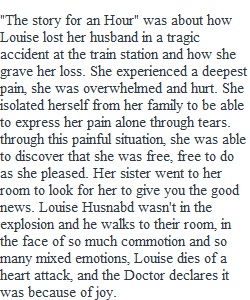


Q The discussions for PLOT will require you to comment on multiple stories. We will be examining "The Story of an Hour" by Kate Chopin, and "How to Talk to Girls at Parties" by Neil Gaiman, and how each author makes use of different PLOT devices. There will actually be THREE separate Discussions: one for each story focusing on a single PLOT element, and a third optional discussion where you can discuss how the stories compare and contrast in the construction of their PLOT. In order to get full credit for these Discussions, you will have to do the following: • Make an original response post to both of the story discussions (3 points each for 6 points total) • Reply to at least two of your classmates, one in each of the two different story discussions (2 points each for 4 points total) • You may make as many additional replies as you wish for deeper, more interesting conversations, and I hope you do. Each response or reply should be substantive and have something new and original to add to the discussion. Posts that say nothing more than, "I agree! or "Good point!" (even if they use a lot of words to say very little) will be deleted and will not count. ----------------------------------------------------------------------------------------------- REQUIRED RESPONSE 1 Kate Chopin's "The Story of an Hour" is very brief but does follow a simple chronological series of events taking place in a single hour. Assume that the Rising Action of the story begins with the third paragraph, the first two serving as Exposition introducing the characters, setting, and source of conflict (news of her husband's death). Trace the Rising Action through to the Climax of the story. Identify as many individual events (things that HAPPEN) that you can in the story and discuss how EACH EVENT helps build the tension or develop the conflict in the story up to the Climax. ----------------------------------------------------------------------------------------------- REQUIRED RESPONSE 2 Neil Gaiman's "How to Talk to Girls at Parties" makes especially good use of Exposition. Assuming the Rising Action starts when the boys enter the party (about paragraph 22), what is revealed in the Exposition about the Characters, Setting, and Source of Conflict that becomes important to understanding the rest of the story? Be sure to include details and examples from the story to make things clear. ----------------------------------------------------------------------------------------------- OPTIONAL DISCUSSION Your first paper (details about which will be posted later) will involve (as one option) analyzing ALL elements of PLOT in a story (NOT one of these--you will select from a list provided.) As practice, use this discussion to talk about what you think these stories have in common and how they differ, specifically related to PLOT--the events in the story and how & why they are revealed in a particular way. As a reminder, use the Checklist on p. 127 to guide your discussion.
View Related Questions